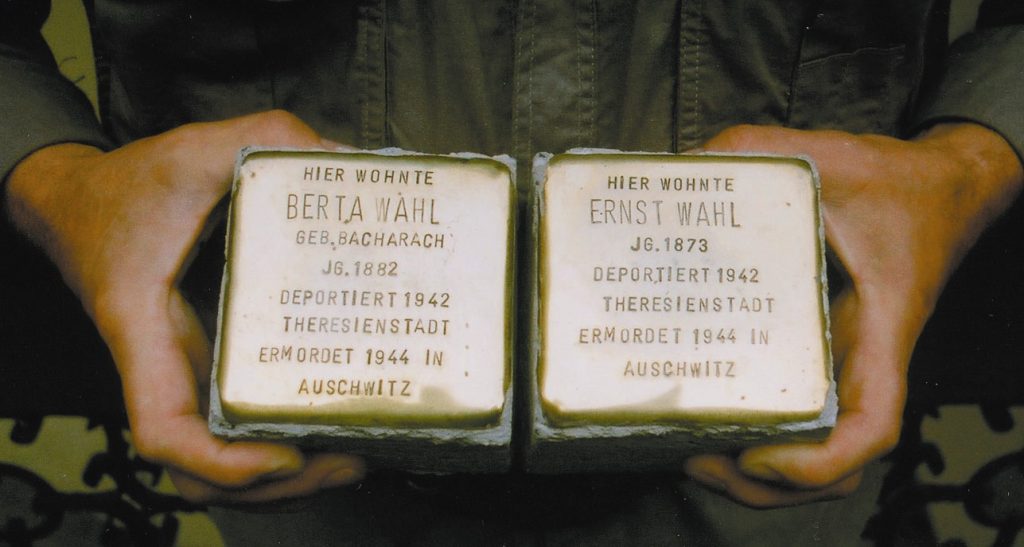Stolperstein
Germany | 2007 | Documentary | 73 min | Digibeta 16:9

Stolpersteine are small brass plates embedded flat in the sidewalk in front of the last residence of Nazi victims. “Here lived” is written on it, followed by a name, the time of the deportation and the place of the murder. There are now over 6,000 of these stones, distributed throughout Germany and soon also Europe (as of the time of filming). Each of them sets an example for an individual fate and allows people today to stumble across this past in their everyday lives. Stumbling blocks are a point of friction, they polarize and have sparked heated public controversy. In cities like Munich, Mainz, Krefeld and Vienna they were (and in some cases still are) banned, while the mayor of Hamburg and the then Federal President Köhler personally advocated for them. Stumbling blocks are damaged or torn out by unknown people, as in Halle, and openly opposed by neo-Nazis. While the Central Council of Jews officially supports the project, various Jewish communities want to prevent the victims’ names from being trampled on.
However, Stolpersteine are a decentralized monument, the largest in the world, which has long since developed its own momentum because it thrives on the commitment of individual citizens. Each stone was co-financed by a private donation. Hundreds of volunteers research the exact dates of the fates on site and ensure the necessary permits. Most do this for victims they never knew and are not related to. Stumbling blocks are also the work of a performance artist who, at least initially, made each one of them with his own hands, brought them to their destination and personally laid them there. Gunter Demnig wants to give the nameless victims back their identities and has thereby triggered an avalanche that now threatens to bury him. Because more and more people want to take part in this project every day, the waiting lists go back to 2007, and with France, Austria, Denmark and the Czech Republic, the stumbling blocks are now also expanding into Europe. The pressure of expectations on Demnig is getting higher and higher.
Stolpersteine are at the center of the film as shiny projection surfaces through which the way we deal with our history is negotiated today and in a very tangible way. They will lead us to people for whom the project has special meaning. For example, Peter Jordan, who, like most of his relatives, sees it as a replacement tombstone for his murdered parents – but has to fight with the city of Munich for his stumbling blocks. Or Ute Latendorf, who regularly polishes hundreds of stumbling blocks all over Hamburg with her friends – for a very personal reason: her fathers were members of the SS. Because stumbling blocks are a democratic form of remembrance work that was not commissioned by any government, we will through them, learn about moving personal stories and experience a heated social controversy that continues to spread across Europe every day.
Director: Dörte Franke
Script: Dörte Franke
Camera: Börres Weiffenbach
Editing: Jana Teuchert
Sound: Mario Köhler u.a.
Editorial staff: Ulrike Dotzer, Christiane Hinz, Franz Grabner
procution lead: Andrea Ufer
Production: Andrea Ufer
Co-Production: Troika Entertainment, Köln
Stations: WDR, NDR/arte, ORF
Funding: Nordmedia
Official selection, Locarno Filmfestival (Schweiz), 2008
“Dokubiber” for best documentary, Filmfest Biberach, 2008
Diploma, International Human Rights Documentary Festival, Kiev (Ukraine), 2008
DOK Leipzig, 2008
Osnabrück, 2008
JFF Amsterdam (Niederlande), 2008
JFF London (UK), 2008
Rom (Italien), 2008
JFF New York (USA), 2009
World Jewish Film Festival Ashkelon (Israel), 2009
JFF Washington (USA), 2009
Pioneer Valley JFF Massachusetts (USA), 2010

Recent Comments